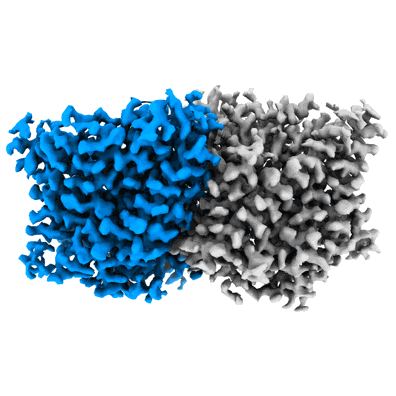EMD-41127
Cryo-EM structure of the human CLC-2 chloride channel transmembrane domain Apo state with resolved N-terminal hairpin
EMD-41127
Single-particle2.46 Å
 Deposition: 26/06/2023
Deposition: 26/06/2023Map released: 31/01/2024
Last modified: 28/02/2024
Sample Organism:
Homo sapiens
Sample: Chloride channel protein 2
Fitted models: 8ta3 (Avg. Q-score: 0.635)
Raw data: EMPIAR-11865, EMPIAR-11864
Deposition Authors: Xu M ,
Neelands T,
Powers AS,
Liu Y
,
Neelands T,
Powers AS,
Liu Y  ,
Miller S,
Pintilie G
,
Miller S,
Pintilie G  ,
Du Bois J
,
Du Bois J  ,
Dror RO
,
Dror RO  ,
Chiu W
,
Chiu W  ,
Maduke M
,
Maduke M 
Sample: Chloride channel protein 2
Fitted models: 8ta3 (Avg. Q-score: 0.635)
Raw data: EMPIAR-11865, EMPIAR-11864
Deposition Authors: Xu M
 ,
Neelands T,
Powers AS,
Liu Y
,
Neelands T,
Powers AS,
Liu Y  ,
Miller S,
Pintilie G
,
Miller S,
Pintilie G  ,
Du Bois J
,
Du Bois J  ,
Dror RO
,
Dror RO  ,
Chiu W
,
Chiu W  ,
Maduke M
,
Maduke M 
CryoEM structures of the human CLC-2 voltage-gated chloride channel reveal a ball-and-chain gating mechanism.
Xu M  ,
Neelands T,
Powers AS,
Liu Y
,
Neelands T,
Powers AS,
Liu Y  ,
Miller SD,
Pintilie GD,
Bois JD,
Dror RO
,
Miller SD,
Pintilie GD,
Bois JD,
Dror RO  ,
Chiu W
,
Chiu W  ,
Maduke M
,
Maduke M 
(2024) eLife , 12
 ,
Neelands T,
Powers AS,
Liu Y
,
Neelands T,
Powers AS,
Liu Y  ,
Miller SD,
Pintilie GD,
Bois JD,
Dror RO
,
Miller SD,
Pintilie GD,
Bois JD,
Dror RO  ,
Chiu W
,
Chiu W  ,
Maduke M
,
Maduke M 
(2024) eLife , 12
Abstract:
CLC-2 is a voltage-gated chloride channel that contributes to electrical excitability and ion homeostasis in many different tissues. Among the nine mammalian CLC homologs, CLC-2 is uniquely activated by hyperpolarization, rather than depolarization, of the plasma membrane. The molecular basis for the divergence in polarity of voltage gating among closely related homologs has been a long-standing mystery, in part because few CLC channel structures are available. Here, we report cryoEM structures of human CLC-2 at 2.46 - 2.76 Å, in the presence and absence of the selective inhibitor AK-42. AK-42 binds within the extracellular entryway of the Cl--permeation pathway, occupying a pocket previously proposed through computational docking studies. In the apo structure, we observed two distinct conformations involving rotation of one of the cytoplasmic C-terminal domains (CTDs). In the absence of CTD rotation, an intracellular N-terminal 15-residue hairpin peptide nestles against the TM domain to physically occlude the Cl--permeation pathway. This peptide is highly conserved among species variants of CLC-2 but is not present in other CLC homologs. Previous studies suggested that the N-terminal domain of CLC-2 influences channel properties via a "ball-and-chain" gating mechanism, but conflicting data cast doubt on such a mechanism, and thus the structure of the N-terminal domain and its interaction with the channel has been uncertain. Through electrophysiological studies of an N-terminal deletion mutant lacking the 15-residue hairpin peptide, we support a model in which the N-terminal hairpin of CLC-2 stabilizes a closed state of the channel by blocking the cytoplasmic Cl--permeation pathway.
CLC-2 is a voltage-gated chloride channel that contributes to electrical excitability and ion homeostasis in many different tissues. Among the nine mammalian CLC homologs, CLC-2 is uniquely activated by hyperpolarization, rather than depolarization, of the plasma membrane. The molecular basis for the divergence in polarity of voltage gating among closely related homologs has been a long-standing mystery, in part because few CLC channel structures are available. Here, we report cryoEM structures of human CLC-2 at 2.46 - 2.76 Å, in the presence and absence of the selective inhibitor AK-42. AK-42 binds within the extracellular entryway of the Cl--permeation pathway, occupying a pocket previously proposed through computational docking studies. In the apo structure, we observed two distinct conformations involving rotation of one of the cytoplasmic C-terminal domains (CTDs). In the absence of CTD rotation, an intracellular N-terminal 15-residue hairpin peptide nestles against the TM domain to physically occlude the Cl--permeation pathway. This peptide is highly conserved among species variants of CLC-2 but is not present in other CLC homologs. Previous studies suggested that the N-terminal domain of CLC-2 influences channel properties via a "ball-and-chain" gating mechanism, but conflicting data cast doubt on such a mechanism, and thus the structure of the N-terminal domain and its interaction with the channel has been uncertain. Through electrophysiological studies of an N-terminal deletion mutant lacking the 15-residue hairpin peptide, we support a model in which the N-terminal hairpin of CLC-2 stabilizes a closed state of the channel by blocking the cytoplasmic Cl--permeation pathway.
